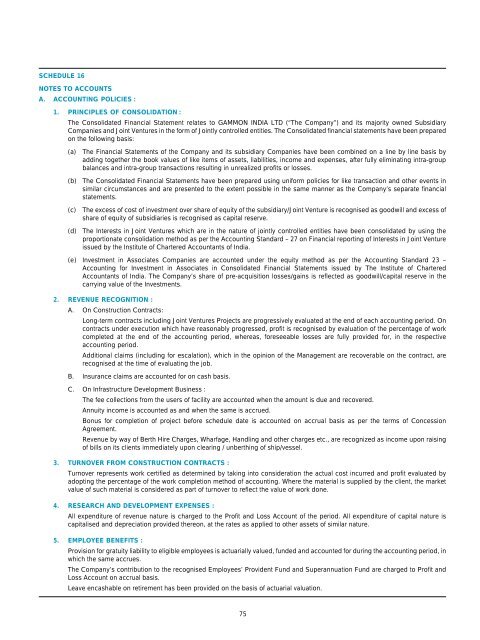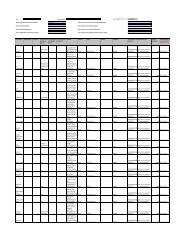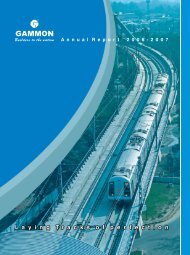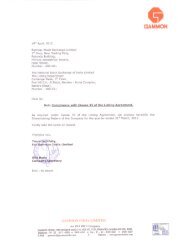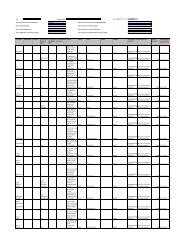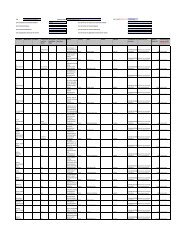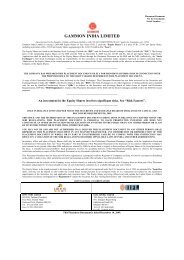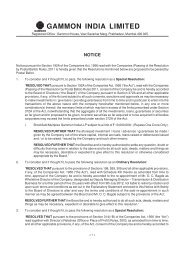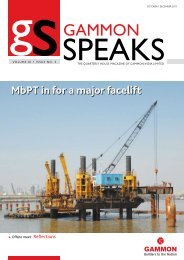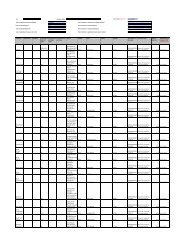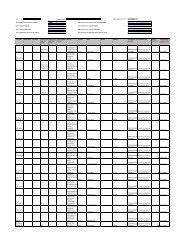Annual Report 2004 - Gammon India
Annual Report 2004 - Gammon India
Annual Report 2004 - Gammon India
You also want an ePaper? Increase the reach of your titles
YUMPU automatically turns print PDFs into web optimized ePapers that Google loves.
SCHEDULE 16<br />
NOTES TO ACCOUNTS<br />
A. ACCOUNTING POLICIES :<br />
1. PRINCIPLES OF CONSOLIDATION :<br />
The Consolidated Financial Statement relates to GAMMON INDIA LTD (“The Company”) and its majority owned Subsidiary<br />
Companies and Joint Ventures in the form of Jointly controlled entities. The Consolidated financial statements have been prepared<br />
on the following basis:<br />
(a) The Financial Statements of the Company and its subsidiary Companies have been combined on a line by line basis by<br />
adding together the book values of like items of assets, liabilities, income and expenses, after fully eliminating intra-group<br />
balances and intra-group transactions resulting in unrealized profits or losses.<br />
(b) The Consolidated Financial Statements have been prepared using uniform policies for like transaction and other events in<br />
similar circumstances and are presented to the extent possible in the same manner as the Company’s separate financial<br />
statements.<br />
(c) The excess of cost of investment over share of equity of the subsidiary/Joint Venture is recognised as goodwill and excess of<br />
share of equity of subsidiaries is recognised as capital reserve.<br />
(d) The Interests in Joint Ventures which are in the nature of jointly controlled entities have been consolidated by using the<br />
proportionate consolidation method as per the Accounting Standard – 27 on Financial reporting of Interests in Joint Venture<br />
issued by the Institute of Chartered Accountants of <strong>India</strong>.<br />
(e) Investment in Associates Companies are accounted under the equity method as per the Accounting Standard 23 –<br />
Accounting for Investment in Associates in Consolidated Financial Statements issued by The Institute of Chartered<br />
Accountants of <strong>India</strong>. The Company’s share of pre-acquisition losses/gains is reflected as goodwill/capital reserve in the<br />
carrying value of the Investments.<br />
2. REVENUE RECOGNITION :<br />
A. On Construction Contracts:<br />
Long-term contracts including Joint Ventures Projects are progressively evaluated at the end of each accounting period. On<br />
contracts under execution which have reasonably progressed, profit is recognised by evaluation of the percentage of work<br />
completed at the end of the accounting period, whereas, foreseeable losses are fully provided for, in the respective<br />
accounting period.<br />
Additional claims (including for escalation), which in the opinion of the Management are recoverable on the contract, are<br />
recognised at the time of evaluating the job.<br />
B. Insurance claims are accounted for on cash basis.<br />
C. On Infrastructure Development Business :<br />
The fee collections from the users of facility are accounted when the amount is due and recovered.<br />
Annuity income is accounted as and when the same is accrued.<br />
Bonus for completion of project before schedule date is accounted on accrual basis as per the terms of Concession<br />
Agreement.<br />
Revenue by way of Berth Hire Charges, Wharfage, Handling and other charges etc., are recognized as income upon raising<br />
of bills on its clients immediately upon clearing / unberthing of ship/vessel.<br />
3. TURNOVER FROM CONSTRUCTION CONTRACTS :<br />
Turnover represents work certified as determined by taking into consideration the actual cost incurred and profit evaluated by<br />
adopting the percentage of the work completion method of accounting. Where the material is supplied by the client, the market<br />
value of such material is considered as part of turnover to reflect the value of work done.<br />
4. RESEARCH AND DEVELOPMENT EXPENSES :<br />
All expenditure of revenue nature is charged to the Profit and Loss Account of the period. All expenditure of capital nature is<br />
capitalised and depreciation provided thereon, at the rates as applied to other assets of similar nature.<br />
5. EMPLOYEE BENEFITS :<br />
Provision for gratuity liability to eligible employees is actuarially valued, funded and accounted for during the accounting period, in<br />
which the same accrues.<br />
The Company’s contribution to the recognised Employees’ Provident Fund and Superannuation Fund are charged to Profit and<br />
Loss Account on accrual basis.<br />
Leave encashable on retirement has been provided on the basis of actuarial valuation.<br />
75


